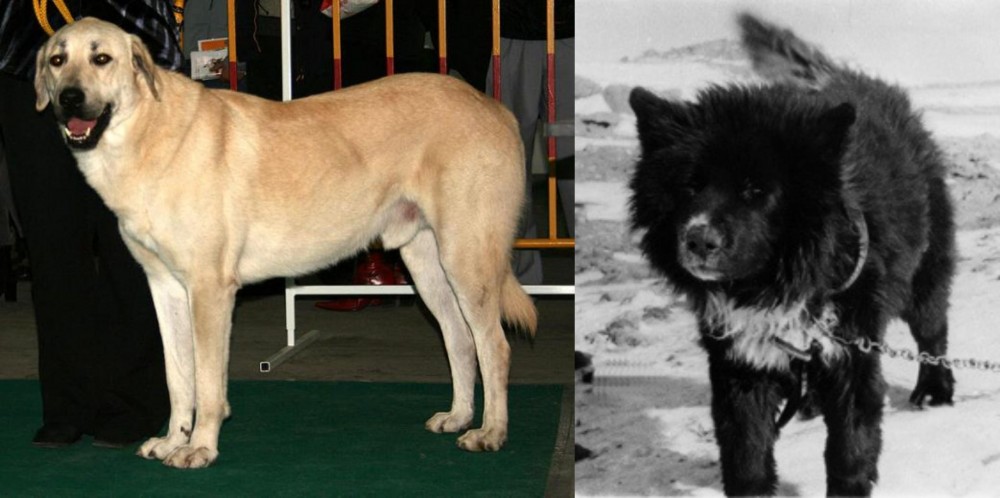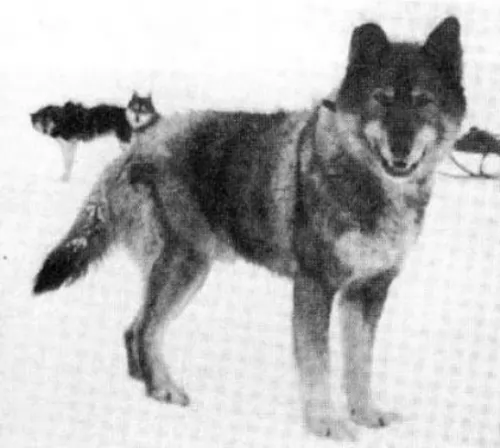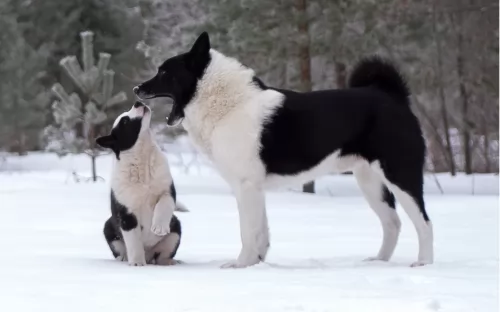 Petzlover
Petzlover Central Anatolian Shepherd is originated from Turkey but Sakhalin Husky is originated from Japan. Central Anatolian Shepherd may grow 10 cm / 4 inches higher than Sakhalin Husky. Central Anatolian Shepherd may weigh 30 kg / 67 pounds more than Sakhalin Husky. Both Central Anatolian Shepherd and Sakhalin Husky has almost same life span. Both Central Anatolian Shepherd and Sakhalin Husky has almost same litter size. Both Central Anatolian Shepherd and Sakhalin Husky requires Moderate Maintenance.
Central Anatolian Shepherd is originated from Turkey but Sakhalin Husky is originated from Japan. Central Anatolian Shepherd may grow 10 cm / 4 inches higher than Sakhalin Husky. Central Anatolian Shepherd may weigh 30 kg / 67 pounds more than Sakhalin Husky. Both Central Anatolian Shepherd and Sakhalin Husky has almost same life span. Both Central Anatolian Shepherd and Sakhalin Husky has almost same litter size. Both Central Anatolian Shepherd and Sakhalin Husky requires Moderate Maintenance.
 The Central Anatolian Shepherd’s lineage is ancient, with the large dog originating from the Anatolia region of central Turkey. He has been used for guarding flocks against predatory wolves and has adapted to living in extreme weather conditions.
The Central Anatolian Shepherd’s lineage is ancient, with the large dog originating from the Anatolia region of central Turkey. He has been used for guarding flocks against predatory wolves and has adapted to living in extreme weather conditions.
The Turkish shepherds would put a spiked collar on the dog to protect him against predators going for the neck of the dog. Today the dog is still being used as a sheep dog and it is closely related to the Kangal Dog.
In 1965 the first pair of Anatolian Shepherds arrived in the UK. A pair were also provided by the Turkish prime minister to the United States government. Today he is a majestic dog still serving man. He is an Anatolian Shepherd Dog, a working dog breed, recognized by the American Kennel Club.
 Known also as the Karafuto-Ken, the Sakhalin Husky is a dog that has been used as a sled dog, but which is now almost extinct.
Known also as the Karafuto-Ken, the Sakhalin Husky is a dog that has been used as a sled dog, but which is now almost extinct.
Hailing from Japan, it is believed that in 2011, there were only two surviving members of the breed in Japan. There isn’t much history on these dogs, but we do know that it is an old breed. They've been used by explorers to the South Pole. One such explorer was Robert Falcon Scott.
They’re extremely tough dogs, known for enduring in the snow under extreme conditions. The dog breed isn’t recognized as a standardized breed by any of the major kennel clubs.
 The Central Anatolian Shepherd is a large,impressive looking dog that possesses great strength, endurance and agility. He is beautiful to look at and is well muscled and strong.
The Central Anatolian Shepherd is a large,impressive looking dog that possesses great strength, endurance and agility. He is beautiful to look at and is well muscled and strong.
He stands at roughly 66-76 cm and weighs 40 to 70kg. The head is large and strong, but in good proportion with the rest of the dog’s body. He has brown eyes and his ears are floppy. The tail is long and set high and when the dog is alert, the tail is carried high, making a wheel shape, otherwise the tail is held low, curling up at the tip.
The short to medium length coarse coat is essentially fawn colored and the dog has a black mask. With the dog, early training and socialization will be needed as he is a strong, stubborn, dominant breed who will require firm leadership from his human owners.
The Central Anatolian Shepherd Dog is a loyal guard dog that becomes possessive over his flock, his human family and anything that he regards as his property. He is aloof around strangers, being suspicious of them.
He will require a firm, positive owner who provides training and socialization. He is an affectionate family pet and gets on well with children who have been taught how to treat dogs and other animals with care and respect. This is a bold, confident dog without aggression who is intelligent, proud and independent.
 This is a medium sized dog standing at between 56 and 66cm in height and weighing between 30 and 40kg. His coat is thick and can be in a number of colours such as brown, tan, cream, grey or black. The ears are small and pointed and slightly tilted forwards. The tail is long and sometimes curls over the back while at other times it is held straight or down.
This is a medium sized dog standing at between 56 and 66cm in height and weighing between 30 and 40kg. His coat is thick and can be in a number of colours such as brown, tan, cream, grey or black. The ears are small and pointed and slightly tilted forwards. The tail is long and sometimes curls over the back while at other times it is held straight or down.
These dogs are known for their loyalty, affection and bravery. The dog is highly intelligent and will respond well to training and socialization.
It's a rare dog breed, calm and confident. A perfect example of their amazing characteristics is seen in the film ‘Eight Below’ where these wonderful dogs were left behind on a scientific expedition that went wrong.
The dogs had to struggle for survival in the frozen wilderness. The Sakhalin Husky just wants to please, and is alert and intelligent, doing well in a family where there are children.
Statues have been erected to honor these Sakhalin Huskies who died on some of these ill-fated expeditions.
These dogs are totally devoted to their owners and they’re full of confidence, they’ve got immense strength and they need a lot of physical stimulation every day.
 The large, rugged Anatolian Shepherd is a dog that has been developed essentially to work as a guardian of livestock. He is a dignified, calm kind of dog who is fiercely possessive of those he guards. He is independent and will require a firm, assertive owner.
The large, rugged Anatolian Shepherd is a dog that has been developed essentially to work as a guardian of livestock. He is a dignified, calm kind of dog who is fiercely possessive of those he guards. He is independent and will require a firm, assertive owner.
He won’t enjoy lying around the home with nothing to do. These are dogs who like to be busy, and therefore he is more a country-life dog than being found in the city on a small property. Make sure that if your pet hasn’t got a working role, that he is provided with exercise, although as a large dog, he isn’t particularly playful and doesn’t require loads of exercise.
Provide him with a caring, loving home and this large, beautiful dog will become your loyal and devoted friend who will guard you with his life.
 When you bring these dogs into your home, you’re bringing in lots of excellent characteristics.
When you bring these dogs into your home, you’re bringing in lots of excellent characteristics.
He is loyal, affectionate and smart. With his above average intelligence, you can easily train him. He is also a playful breed and the kids will enjoy him as a good playmate.
They’re gentle dogs too and will do well in a home where people are fair, patient, kind and consistent with their handling of him. Known to be an excellent therapy dog, having this dog in your home will enhance your quality of life.
 The Anatolian Shepherd Dog is a hardy, healthy dog who isn’t likely to get sick easily. The dog can live to be 11, 12, 13 years of age when he receives excellent care. Like any pure breed though, he is susceptible to hereditary disorders and some of the other common health issues.
The Anatolian Shepherd Dog is a hardy, healthy dog who isn’t likely to get sick easily. The dog can live to be 11, 12, 13 years of age when he receives excellent care. Like any pure breed though, he is susceptible to hereditary disorders and some of the other common health issues.
This condition is always a problem with a big dog. It’s an abnormal development of the hip joint and it can cause lameness and painful arthritis of the joints. It is brought about by a combination of environmental- as well as genetic factors.
This is a common type of blood cell cancer diagnosed in dogs. Lymphoid tissue is present in quite a few places in the body including lymph nodes, liver and spleen, and dogs of any age can be affected.
 The brave Sakhalin Husky can live to be between 12 and 14 years of age but these dogs can succumb to quite a few of the common dog diseases there are -
The brave Sakhalin Husky can live to be between 12 and 14 years of age but these dogs can succumb to quite a few of the common dog diseases there are -
This is a hereditary disease of the cornea. You’ll see small white dots in his cornea and the dog can experience hazy vision.
This problem with the hips can be debilitating for your sled dog, and both hips can be affected. It can be painful for your dog as arthritis sets in. It is important to see that your dogs don’t put on weight as this puts pressure on the joints. Your dog will need to see the vet, and surgery might be a treatment option.
This is a condition that affects Huskies between 3 and 4 months of age and can result in hair loss or problems with the skin. It is actually fairly rare in dogs and diagnosed by microscopic examination of the hair shaft. You will need to get your pet to the vet because it can lead to alopecia.
 The Central Anatolian Shepherd sheds fairly heavily so he will require brushing at least twice a week. Grooming is important and won’t only include brushing, but ear cleaning and nail trimming too as well as proper dental hygiene.
The Central Anatolian Shepherd sheds fairly heavily so he will require brushing at least twice a week. Grooming is important and won’t only include brushing, but ear cleaning and nail trimming too as well as proper dental hygiene.
A dog such as the Anatolian Shepherd, with his floppy ears, will also need to have his ears checked and cleaned to avoid ear infections. There are some of these dogs where the hair needs to be plucked from the ear canal to ensure proper air circulation.
It is important that you are skilled to clean the ears properly, and if in any doubt, to avoid damage to the ear, consult your vet for sound advice.
 Feed your Sakhalin Husky a commercially manufactured dog formula that caters to his energy and digestive needs.
Feed your Sakhalin Husky a commercially manufactured dog formula that caters to his energy and digestive needs.
Choose high-quality dog food with natural ingredients. Try and include some home-made food into your dogs diet. Boiled chicken, brown rice or pasta, sweet potatoes, carrots and spinach will do him wonders and you can chop it up and add some into the dry kibble as a treat twice a week.
Some raw meat occasionally is also important to prevent skin problems. Be sure that cool, fresh water is available for your pet at all times.
This will require regular exercise. Walks are always good, but he will require something more hectic such as long hikes and frisbee or ball throwing games.
A Husky’s dense double-coat must be brushed at least twice a week as he is a fairly heavy shedder.
His nails grow quickly and these will need to be trimmed. Even though he has erect ears, you will need to check inside for cleanliness to avoid canine ear infections.
Check inside his mouth as well for bad teeth as these can have a detrimental affect on his health